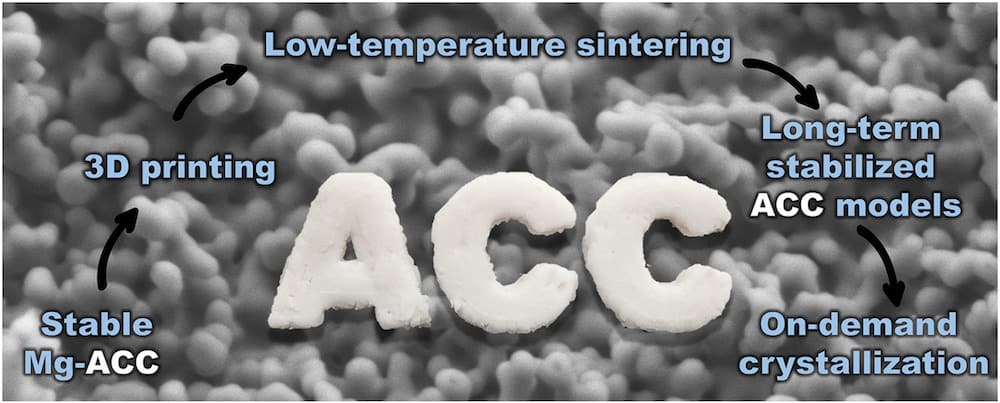
[Image above] Researchers in Israel developed a new low-temperature 3D printing process using amorphous calcium carbonate. Credit: Shaked et al., Materials Today Bio (CC BY-NC-ND 4.0)
In the past decade, the ability to 3D print ceramic materials grew by leaps and bounds, as evidenced by talks at the annual 2021 Ceramics Expo. However, manufacturers still face limits to what 3D printing can achieve.
For example, many ceramic additive manufacturing methods use organic or polymeric binders to hold ceramic particles together during deposition, after which they are burned away during heat treatment and sintering. The high temperatures required to harden the printed material means the final ceramic part will not retain any organic additives, which limits the types of functional ceramic materials you can produce via 3D printing.
Developing a low-temperature printing process would allow for the realization of printed ceramic materials featuring organic additives, and a recent open-access paper suggests a way to achieve this goal.
The researchers come from Technion – Israel Institute of Technology in Haifa, Israel. They developed the new low-temperature printing processing using a metastable polymorph that has gained increasing interest of late—amorphous calcium carbonate (ACC).
ACC is the amorphous and least stable polymorph of calcium carbonate, a versatile biomineral used for a variety of industrial purposes. Researchers are interested in ACC due to its widespread function as a precursor to crystalline calcium carbonate. The amorphous-to-crystalline transformation facilitates incorporation of organic and inorganic additives into the final structure.
Up to now, many researchers discounted the possibility of 3D printing with ACC due its heat intolerance as well as inability to remain stable for long periods of time. However, the Israeli researchers believed they could overcome these limitations by doping ACC with magnesium, which increases the stability of ACC.
They created a high-magnesium ACC powder by mixing aqueous solutions of CaCl2•2H2O, MgCl2•6H20, and Na2CO3 and then filtering the suspension. They maintained the amorphous nature of the ACC powder by submerging it in excess acetone until they accumulated enough powder to mix it with a dispersant and one of three different binders to form a paste.
They extruded the paste through a thin nozzle and placed the printed models in a vacuum oven for low-temperature sintering overnight at 150°C. Then, they transferred the models to an autoclave for the final crystallization step under humid conditions at 100°C before drying the models in a vacuum oven at 75°C.

The researchers used several microscopy, X-ray diffraction, and rheology techniques to analyze the pastes and final printed models.
They found that pastes created using either ethylene glycol or triethylene glycol as the binder preserved their amorphous nature even after oven sintering, and the amorphous nature was retained for up to several months. In contrast, paste created using glycerol as the binder demonstrated complete crystallization after oven sintering, possibly due to its highly hygroscopic nature.
All the pastes experienced rapid crystallization after sintering in the autoclave, and post-sintered models exhibited no shrinkage and maintained their initial dimensions and complex shapes. The models created using glycerol as the binder formed larger crystals with higher magnesium incorporation than models containing either ethylene glycol or triethylene glycol.
“This novel approach to 3D printing of ACC may highlight the advantages of this phase as a precursor to crystalline CaCO3 and open new routes to energy-efficient 3D printing of ceramics for multiple applications,” the researchers conclude.
The open-access paper, published in Materials Today Bio, is “Long-term stabilized amorphous calcium carbonate—an ink for bio-inspired 3D printing” (DOI: 10.1016/j.mtbio.2021.100120).
